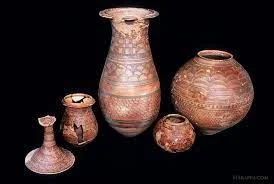Introduction
Indus Valley Civilisation pottery showcases advanced techniques and diverse forms, offering insights into ancient trade, culture, and society in the Indian subcontinent.
Characteristics of Pottery of Indus Valley Civilisation
- Making: The Indus Valley pottery consists chiefly of very fine wheel-made wares, very few being hand-made.
- Red Clay: Plain pottery of Indus Valley Civilisation is generally of red clay, with or without a fine red or gray slip.
- The black-painted ware has a fine coating of red slip on which geometric and animal designs are executed in glossy black paint.
- Polychrome Pottery: Rare and mainly consisted of small vases decorated with geometric patterns in red, black, green, rarely white and yellow.
- Incised Ware: Rare with incised decoration confined to the bases of pots.

Uses of Pottery of Indus Valley Civilisation
- Perforated pottery with large holes at the bottom and small holes all over the wall was probably used for straining the liquor.
- Miniature vessels, generally less than half an inch in size, were used for decorative purposes.
- Pottery for household purposes was found in all shapes and sizes. Graceful curves were used, while straight and angular shapes were an exception.
Conclusion
- The pottery of the Indus Valley Civilisation remains an invaluable archaeological treasure, illuminating the sophistication and cultural vibrancy of one of the world’s earliest urban societies.
![]() April 12, 2024
April 12, 2024
![]() 13851
13851
![]() 0
0
